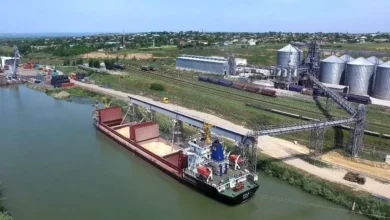Spring Storm Flooding: Catastrophic Impact on the South

As spring storms sweep through the South and Midwest, the threat of spring storm flooding looms ever larger, bringing with it catastrophic consequences. Meteorologists have issued heavy rainfall warnings, predicting that several regions may experience severe flooding risks as weather systems stall and release an overwhelming amount of rain. Communities across states like Kentucky and Tennessee are bracing for potential disaster, as the forecast indicates an additional 6 to 12 inches of rain could fall in already saturated areas. Tragically, lives have been lost as floodwaters rise, with rescue efforts underway to assist those caught in the torrential downpour. With conditions poised to worsen, preparedness is essential to mitigate the impacts of these devastating flooding events that could affect millions of residents this spring.
The onset of spring often brings storms that can lead to significant flooding in various regions, highlighting the alarming threat of water inundation. Due to intense and persistent rainfall, areas currently facing extreme weather are at risk of devastating conditions marked by rising waters and emergency evacuations. Flood emergencies are compounded by factors like tornado threats in the Midwest, with rescue operations becoming crucial as communities grapple with the aftermath of these severe weather patterns. The situation demands vigilance and proactive measures, as these flooding phenomena can wreak havoc on lives and property alike. Overall, understanding and responding to these severe weather alerts is vital for ensuring safety and minimizing the impact of nature’s fury.
Understanding Spring Storm Flooding Risks in the South
Spring storms in the southern United States bring with them significant flooding risks that locals must be aware of. Heavy rainfall often leads to flash floods, particularly in areas that have previously experienced saturation from earlier storms. For instance, towns like Little Rock, Arkansas, and Paducah, Kentucky, find themselves under constant watch as additional rainfall adds to already existing water levels, making them susceptible to flooding events that could be classified as catastrophic. Each year, communities brace themselves as meteorologists predict the potential for such dangers, and this spring has proven to be no exception.
Flooding risks increase significantly during storm events where rainfall accumulates rapidly. Residents must pay close attention to weather alerts and be prepared for evacuation orders in flood-prone areas, particularly as rivers and creeks may overflow. The recent storm in the southern states has highlighted just how quickly conditions can change, leading to tragic consequences. As the death toll rises and communities face devastation, it becomes crucial to advocate for personal preparedness and community awareness to mitigate the impacts of these potentially deadly weather phenomena.
The Threat of Tornadoes in the Midwest During Spring Storms
Midwest states often face unique weather challenges in spring, particularly tornado threats. As warm, moist air rises from the Gulf of Mexico, it meets colder air from Canada, creating a volatile atmosphere ripe for thunderstorms and tornadoes. In cities like Nashville, Tennessee, and across parts of Indiana, the severe weather not only brings heavy rainfall but also increases the risk of tornado development. Residents are advised to remain vigilant and stay tuned into weather forecasts during this turbulent season.
Safety and preparedness are paramount when addressing the threat of tornadoes that accompany spring storms. Communities in regions like the Midwest have learned to take warnings seriously, investing in storm shelters and ensuring that they have emergency plans in place. The combination of tornado threats and heavy rainfall can significantly amplify disaster risks, and understanding how to react swiftly can mean the difference between safety and tragedy.
Heavy Rainfall Warnings: Why They Matter
Heavy rainfall warnings are crucial alerts that can help save lives during severe weather events. This spring, many regions, including parts of Kentucky and Tennessee, face ominous forecasts projecting up to 12 inches of rain in just a short period. Such accumulations can overwhelm local drainage systems and create hazardous conditions, leading to flash floods and requiring swift action from emergency services. Understanding these warnings and their implications is vital for effective disaster response and public safety.
When alerts for heavy rainfall are issued, it’s essential for individuals and families to take them seriously. This means preparing an emergency kit, having a clear communication plan, and staying informed about the latest weather updates. Failure to heed these warnings can lead to dangerous circumstances, as evidenced by the tragic stories emerging from Louisiana and Arkansas. Awareness of heavy rainfall warnings not only empowers communities but can also mobilize flood rescue efforts, helping those in distress before the situation worsens.
Recent Flood Rescue Efforts: A Community’s Response
In the wake of devastating storms, flood rescue efforts are imperative to ensure the safety and survival of those affected. As river levels rise and roadways become submerged, emergency responders work tirelessly to reach individuals in peril. This was evident during recent flooding across multiple states where rescue teams bravely navigated dangerous conditions to assist stranded residents. Situations arose in areas like Shelby County, Indiana, where mandatory evacuations highlighted the urgent need for coordinated rescue responses.
The strength of community during these catastrophic flooding events cannot be overstated. Neighbors often band together to assist one another, sharing resources and providing shelter to those displaced by floodwaters. Local organizations and volunteers play a critical role in these efforts, exemplifying community resilience in the face of adversity. Flood rescue operations not only reflect the challenges posed by nature but also underscore the importance of preparedness and teamwork among citizens during such crises.
The Dangers of Catastrophic Flooding Events
Catastrophic flooding events can lead to extensive damage, loss of life, and long-term challenges for affected communities. The recent storm has provided a stark reminder of how quickly conditions can escalate from heavy rainfall to widespread flooding. In Kentucky, for instance, reports highlight tragic incidents where individuals were swept away by floodwaters, showcasing the inherent dangers of such events. Understanding the signs of catastrophic flooding is vital for both personal safety and community awareness.
As regions adapt to the increasing frequency of catastrophic flooding events, it is crucial to prioritize effective infrastructure and disaster preparedness strategies. Floodplain management and the maintenance of drainage systems are essential for reducing the impacts of heavy rains and ensuring that emergency services can respond efficiently. Community engagement in flood preparedness can also foster a culture of resilience, ultimately equipping individuals with the knowledge and tools necessary to navigate these increasingly perilous weather patterns.
Preparing for Future Spring Storm Flooding
In light of the risks associated with spring storm flooding, effective preparation is essential for safeguarding lives and property. Communities should implement comprehensive hazard assessments to identify vulnerable areas and develop tailored response strategies. Simple steps such as participating in local preparedness training sessions and building emergency kits can significantly enhance personal and community readiness. Moreover, leveraging technology for real-time weather updates can help keep individuals informed about changing conditions.
Education is a key component in preparing for future spring storm flooding. Schools and local organizations can serve as platforms to educate the community about flood risks, mitigation strategies, and practical safety measures. Additionally, local governments should focus on promoting active discussions about flood preparedness, emphasizing the importance of community involvement in emergency planning. As daunting as spring storms can be, proactive measures can help mitigate their impact and foster resilience in the face of adversity.
Public Awareness of Flooding Forecasts and Alerts
Public awareness of flooding forecasts and alerts plays a crucial role in ensuring safety during severe weather events. With the advent of advanced meteorological technologies, residents can receive real-time updates on potential flooding threats, allowing them to take necessary precautions. Spring storms can escalate quickly, and staying informed about impending weather conditions can be critical in preventing loss of life and property. Alerts and forecasts should be recognized as essential tools for preparedness.
Furthermore, community outreach initiatives to educate the public on how to respond to flooding advisories can also help reduce panic during emergencies. By practicing evacuation drills and encouraging residents to familiarize themselves with local flood zones, communities can cultivate a proactive mindset. Awareness campaigns can integrate the dissemination of information regarding the risks associated with spring storm flooding, fostering a culture of safety that empowers individuals to act swiftly and wisely when the situation calls for it.
The Importance of Emergency Preparedness Kits During Flooding
Having an emergency preparedness kit is vital for individuals and families, especially during periods prone to flooding. An effective kit includes essential items such as non-perishable food, drinking water, flashlights, communication devices, and first aid supplies. In light of spring storms, it is crucial to regularly assess and update these kits to ensure readiness for any sudden flood events that may occur. The increase in severe weather patterns underlines the need for a comprehensive approach to disaster preparedness.
In addition to basic supplies, families should also consider including important documents in their emergency kits, such as identification, home insurance papers, and medication. This forward-thinking approach not only safeguards personal belongings but also streamlines recovery efforts following a flood event. Ultimately, the ability to promptly gather necessary supplies in a moment of crisis can make a significant difference for those facing the challenges associated with spring storm flooding.
Infrastructure Resilience Against Spring Storm Flooding
The resilience of infrastructure is critical in mitigating the effects of spring storm flooding. Well-maintained drainage systems can significantly reduce water accumulation in urban areas, minimizing the risk of flooding during heavy rainstorms. Investment in flood control measures, such as levees and retention basins, can also provide communities with the necessary defenses against excessive water levels. As climate patterns change, many regions must re-evaluate their infrastructure to adequately prepare for increasingly severe weather events.
In light of recent flooding events, it becomes apparent that community involvement in infrastructure planning is essential. Engaging residents in discussions about local flood management strategies ensures that solutions are tailored to specific areas and their unique challenges. Enhanced collaboration between public agencies and local communities can lead to more resilient infrastructure, ultimately promoting safety during dangerous storms. By investing in smarter, sustainable designs, cities can better withstand the impacts of future spring storm flooding.
Frequently Asked Questions
What should I know about spring storm flooding risks in the South?
Spring storm flooding risks in the South are elevated due to heavy rainfall that can lead to catastrophic flooding events. Areas can receive 6 to 12 inches of rain in a short period, causing flash floods and hazardous conditions. It’s important to stay updated with local weather warnings and adhere to evacuation orders if necessary.
How do tornado threats in the Midwest affect flooding risks during spring storms?
Tornado threats in the Midwest can coincide with heavy rain from spring storms, increasing flooding risks. Tornado conditions can lead to rapid storm development, resulting in torrential downpours and flooding in affected areas. Communities should be prepared for both tornado and flooding alerts during severe weather events.
What are some current heavy rainfall warnings related to upcoming spring storm flooding?
Heavy rainfall warnings during spring storms indicate that significant rain accumulation is expected, often leading to flooding risks. Areas across the South and Midwest are currently under warnings, with forecasts suggesting additional inches of rain that may exacerbate existing flooding situations.
What steps should be taken to ensure safety during flood rescue efforts in spring storms?
During flood rescue efforts related to spring storm flooding, it is crucial to prioritize safety. Always follow emergency instructions, avoid flooded roads, and do not attempt to drive through water. Stay informed through local news and weather channels and prepare an emergency kit if evacuation becomes necessary.
What are signs of catastrophic flooding events during spring storms?
Signs of catastrophic flooding events during spring storms include rapidly rising water levels, road closures due to high water, and significant rainfall forecasts. If you see flash flood warnings or experience sustained heavy rain, it’s vital to take immediate action to protect yourself and evacuate if instructed.
How can communities prepare for the potential effects of spring storm flooding?
Communities can prepare for potential spring storm flooding by establishing emergency response plans, conducting drills, and ensuring that residents are educated on flood risks. It’s essential to have an evacuation plan in place and to stay informed of weather updates from local authorities.
Why is it crucial to heed flood warnings during heavy rainfall in late spring?
Heeding flood warnings during heavy rainfall is crucial because conditions can change rapidly, leading to life-threatening situations. Late spring storms may bring unexpected amounts of rain, making even minor flooding potentially dangerous. Always prioritize safety and follow local advisories.
What areas are most vulnerable to flooding during spring storms?
Areas that are flat, near rivers, or have poor drainage systems are most vulnerable to flooding during spring storms. Regions in the South and Midwest, including cities like Little Rock and Paducah, often experience inundation due to spring storm flooding, particularly after heavy rainfall.
How can I stay informed about spring storm flooding in my area?
To stay informed about spring storm flooding, regularly check local news outlets, follow the National Weather Service on social media, and subscribe to emergency alerts. Understanding local weather patterns and flood risks is critical to ensure your safety during severe weather events.
What impact does flooding from spring storms have on infrastructure and homes?
Flooding from spring storms can severely damage infrastructure and homes, leading to costly repairs and potential loss of property. Floodwaters can erode foundations, destroy roads and bridges, and impact essential services, highlighting the importance of flood preparedness and mitigation efforts.
| Key Point | Details |
|---|---|
| Severe Storm Impact | The storm system has resulted in at least eight fatalities and dangerous flooding across several states. |
| Rainfall Predictions | Predictions indicate an additional 6 to 12 inches of rain in already affected areas, particularly from Friday evening to Sunday morning. |
| Flood Watches Issued | Over 42 million people from Oklahoma to Pennsylvania are under flood watches or warnings due to the storm’s intensity. |
| Specific Local Impacts | Downtown Hopkinsville, KY has flooded with predictions of record-level flooding and additional rainfall expected. |
| Evacuation Orders | Mandatory evacuations have been issued in flood-prone areas of Shelbyville and Shelby County, Indiana. |
| National Weather Service Advisory | Forecasts highlight a high risk of life-threatening flash flooding across major cities to continue through the weekend. |
Summary
Spring storm flooding has emerged as a significant threat this season, with rising water levels leading to catastrophic events in multiple states. As the storm system continues to unleash heavy rain, residents are urged to stay vigilant and heed warnings from local officials. The extensive rainfall, combined with prior flooding, could result in unprecedented water levels, making safety a priority for everyone in affected regions.




